Improvement of Exciton Collection and Light-Harvesting Range in Ternary Blend Polymer Solar Cells Based on Two Non-Fullerene Acceptors
Abstract
1. Introduction
2. Materials and Methods
2.1. Materials
2.2. Device Fabrication
2.3. Measurements
3. Results
3.1. Optoelectronic Properties
3.2. J–V Characteristics
3.3. External Quantum Efficiency (EQE) Spectra
4. Discussion
5. Conclusions
Author Contributions
Funding
Acknowledgments
Conflicts of Interest
References
- Nayak, P.K.; Mahesh, S.; Snaith, H.J.; Cahen, D. Photovoltaic solar cell technologies: Analysing the state of the art. Nat. Rev. Mater. 2019, 4, 269–285. [Google Scholar] [CrossRef]
- Hou, W.; Xiao, Y.; Han, G.; Lin, J.Y. The applications of polymers in solar cells: A review. Polymers 2019, 11, 143. [Google Scholar] [CrossRef]
- Li, Y.; Xu, G.; Cui, C.; Li, Y. Flexible and semitransparent organic solar cells. Adv. Energy Mater. 2018, 8, 1701791. [Google Scholar] [CrossRef]
- Mateker, W.R.; McGehee, M.D. Progress in understanding degradation mechanisms and improving stability in organic photovoltaics. Adv. Mater. 2017, 29, 1603940. [Google Scholar] [CrossRef]
- Dennler, G.; Scharber, M.C.; Brabec, C.J. Polymer-fullerene bulk-heterojunction solar cells. Adv. Mater. 2009, 21, 1323–1338. [Google Scholar] [CrossRef]
- He, Z.; Xiao, B.; Liu, F.; Wu, H.; Yang, Y.; Xiao, S.; Wang, C.; Russell, T.P.; Cao, Y. Status and prospects for ternary organic photovoltaics. Nat. Photonics 2015, 9, 174–179. [Google Scholar] [CrossRef]
- Liu, Y.; Zhao, J.; Li, Z.; Mu, C.; Ma, W.; Hu, H.; Jiang, K.; Lin, H.; Ade, H.; Yan, H. Aggregation and morphology control enables multiple cases of high-efficiency polymer solar cells. Nat. Commun. 2014, 5, 6293. [Google Scholar] [CrossRef]
- Liang, Y.; Xu, Z.; Xia, J.; Tsai, S.T.; Wu, Y.; Li, G.; Ray, C.; Yu, L. For the bright future—bulk heterojunction polymer solar cells with power conversion efficiency of 7.4%. Adv. Mater. 2010, 22, E135–E138. [Google Scholar] [CrossRef]
- Park, S.H.; Roy, A.; Beaupre, S.; Cho, S.; Coates, N.; Moon, J.S.; Moses, D.; Leclerc, M.; Lee, K.; Heeger, A.J. Bulk heterojunction solar cells with internal quantum efficiency approaching 100%. Nat. Photonics 2009, 3, 297–303. [Google Scholar] [CrossRef]
- Li, G.; Shrotriya, V.; Huang, J.; Yao, Y.; Moriarty, T.; Emery, K.; Yang, Y. High-efficiency solution processable polymer photovoltaic cells by self-organization of polymer blends. Nat. Mater. 2005, 4, 864–868. [Google Scholar] [CrossRef]
- Lin, Y.; Wang, J.; Zhang, Z.G.; Bai, H.; Li, Y.; Zhu, D.; Zhan, X. An electron acceptor challenging fullerenes for efficient polymer solar cells. Adv. Mater. 2015, 27, 1170–1174. [Google Scholar] [CrossRef]
- Genene, Z.; Mammo, W.; Wang, E.; Andersson, M.R. Recent advances in n-type polymers for all-polymer solar cells. Adv. Mater. 2019, 31, 1807275. [Google Scholar] [CrossRef]
- Wadsworth, A.; Moser, M.; Marks, A.; Little, M.S.; Gasparini, N.; Brabec, C.J.; Baran, D.; McCulloch, I. Critical review of the molecular design progress in non-fullerene electron acceptors towards commercially viable organic solar cells. Chem. Soc. Rev. 2019, 48, 1596–1625. [Google Scholar] [CrossRef]
- Hou, J.; Inganäs, O.; Friend, R.H.; Gao, F. Organic solar cells based on non-fullerene acceptors. Nat. Mater. 2018, 17, 119–128. [Google Scholar] [CrossRef]
- Chen, W.; Zhang, Q. Recent progress in non-fullerene small molecule acceptors in organic solar cells (OSCs). J. Mater. Chem. C 2017, 5, 1275–1302. [Google Scholar] [CrossRef]
- Liu, Q.; Jiang, Y.; Jin, Y.; Qin, J.; Xu, J.; Li, W.; Xiong, J.; Liu, J.; Xiao, Z.; Sun, K.; et al. 18% efficiency organic solar cells. Sci. Bull. 2020. [Google Scholar] [CrossRef]
- Fan, B.; Zhang, D.; Li, M.; Zhong, W.; Zeng, Z.; Ying, L.; Huang, F.; Cao, Y. Achieving over 16% efficiency for single-junction organic solar cells. Sci. China Chem. 2019, 62, 746–752. [Google Scholar] [CrossRef]
- Yuan, J.; Zhang, Y.; Zhou, L.; Zhang, G.; Yip, H.L.; Lau, T.K.; Lu, X.; Zhu, C.; Peng, H.; Johnson, P.A.; et al. Single-junction organic solar cell with over 15% efficiency using fused-ring acceptor with electron-deficient core. Joule 2019, 3, 1140–1151. [Google Scholar] [CrossRef]
- Xu, X.; Feng, K.; Bi, Z.; Ma, W.; Zhang, G.; Peng, Q. Single-junction polymer solar cells with 16.35% efficiency enabled by a platinum (II) complexation strategy. Adv. Mater. 2019, 31, 1901872. [Google Scholar] [CrossRef]
- Liu, B.; Wang, Y.; Chen, P.; Zhang, X.; Sun, H.; Tang, Y.; Liao, Q.; Huang, J.; Wang, H.; Meng, H.; et al. Boosting efficiency and stability of organic solar cells using ultralow-cost BiOCl nanoplates as hole transporting layers. ACS Appl. Mater. Interfaces 2019, 11, 33505–33514. [Google Scholar] [CrossRef]
- Chang, Y.; Lau, T.K.; Pan, M.A.; Lu, X.; Yan, H.; Zhan, C. The synergy of host–guest nonfullerene acceptors enables 16%-efficiency polymer solar cells with increased open-circuit voltage and fill-factor. Mater. Horiz. 2019, 6, 2094–2102. [Google Scholar] [CrossRef]
- Gasparini, N.; Salleo, A.; McCulloch, I.; Baran, D. The role of the third component in ternary organic solar cells. Nat. Rev. Mater. 2019, 4, 229–242. [Google Scholar] [CrossRef]
- Rasi, D.D.C.; Janssen, R.A.J. Advances in solution-processed multijunction organic solar cells. Adv. Mater. 2019, 31, 1806499. [Google Scholar] [CrossRef] [PubMed]
- Wang, Y.; Wang, T.; Chen, J.; Kim, H.D.; Gao, P.; Wang, B.; Iriguchi, R.; Ohkita, H. Quadrupolar D–A–D diketopyrrolopyrrole-based small molecule for ternary blend polymer solar cells. Dyes Pig. 2018, 158, 213–218. [Google Scholar] [CrossRef]
- Wang, Y.; Chen, J.; Kim, H.D.; Wang, B.; Iriguchi, R.; Ohkita, H. Ternary blend solar cells based on a conjugated polymer with diketopyrrolopyrrole and carbazole units. Front. Energy Res. 2018, 6, 113. [Google Scholar] [CrossRef]
- Wang, Y.; Kim, H.D.; Wang, B.; Ohkita, H. Visible sensitization for non-fullerene polymer solar cells using a wide bandgap polymer. J. Photopolym. Sci. Technol. 2018, 31, 177–181. [Google Scholar] [CrossRef]
- Xu, H.; Ohkita, H.; Tamai, Y.; Benten, H.; Ito, S. Interface engineering for ternary blend polymer solar cells with a heterostructured near-IR dye. Adv. Mater. 2015, 27, 5868–5874. [Google Scholar] [CrossRef]
- Wang, Y.; Ohkita, H.; Benten, H.; Ito, S. Highly efficient exciton harvesting and charge transport in ternary blend solar cells based on wide- and low-bandgap polymers. Phys. Chem. Chem. Phys. 2015, 17, 27217–27224. [Google Scholar] [CrossRef]
- Wang, Y.; Zheng, B.; Tamai, Y.; Ohkita, H.; Benten, H.; Ito, S. Dye sensitization in the visible region for low-bandgap polymer solar cells. J. Electrochem. Soc. 2014, 161, D3093–D3096. [Google Scholar] [CrossRef]
- Xu, H.; Ohkita, H.; Hirata, T.; Benten, H.; Ito, S. Near-IR dye sensitization of polymer blend solar cells. Polymer 2014, 55, 2856–2860. [Google Scholar] [CrossRef]
- Xu, H.; Wada, T.; Ohkita, H.; Benten, H.; Ito, S. Dye sensitization of polymer/fullerene solar cells incorporating bulky phthalocyanines. Electrochim. Acta 2013, 100, 214–219. [Google Scholar] [CrossRef]
- Honda, S.; Ohkita, H.; Benten, H.; Ito, S. Selective dye loading at the heterojunction in polymer/fullerene solar cells. Adv. Energy Mater. 2011, 1, 588–598. [Google Scholar] [CrossRef]
- Honda, S.; Ohkita, H.; Benten, H.; Ito, S. Multi-colored dye sensitization of polymer/fullerene bulk heterojunction solar cells. Chem. Commun. 2010, 46, 6596–6598. [Google Scholar] [CrossRef] [PubMed]
- Honda, S.; Nogami, T.; Ohkita, H.; Benten, H.; Ito, S. Improvement of the light-harvesting efficiency in polymer/fullerene bulk heterojunction solar cells by interfacial dye modification. ACS Appl. Mater. Interfaces 2009, 4, 804–810. [Google Scholar] [CrossRef]
- Ameri, T.; Min, J.; Li, N.; Machui, F.; Baran, D.; Forster, M.; Schottler, K.J.; Dolfen, D.; Scherf, U.; Brabec, C.J. Performance enhancement of the P3HT/PCBM solar cells through NIR sensitization using a small-bandgap polymer. Adv. Energy Mater. 2012, 2, 1198–1202. [Google Scholar] [CrossRef]
- Li, J.; Liang, Z.; Peng, Y.; Lv, J.; Ma, X.; Wang, Y.; Xia, Y. 36% Enhanced efficiency of ternary organic solar cells by doping a NT-based polymer as an electron-cascade donor. Polymers 2018, 10, 703. [Google Scholar] [CrossRef]
- Zhang, M.; Zhang, F.; An, Q.; Sun, Q.; Wang, J.; Li, L.; Wang, W.; Zhang, J. High efficient ternary polymer solar cells based on absorption complementary materials as electron donor. Sol. Energy Mater. Sol. Cells 2015, 141, 154–161. [Google Scholar] [CrossRef]
- Shen, W.; Chen, W.; Zhu, D.; Zhang, J.; Xu, X.; Jiang, H.; Wang, T.; Wang, E.; Yang, R. High-performance ternary polymer solar cells from a structurally similar polymer alloy. J. Mater. Chem. A 2017, 5, 12400–12406. [Google Scholar] [CrossRef]
- An, Q.; Zhang, F.; Zhang, J.; Tang, W.; Wang, Z.; Li, L.; Xu, Z.; Teng, F.; Wang, Y. Enhanced performance of polymer solar cells through sensitization by a narrow band gap polymer. Sol. Energy Mater. Sol. Cells 2013, 118, 30–35. [Google Scholar] [CrossRef]
- Wang, Y.; Ohkita, H.; Benten, H.; Ito, S. Efficient exciton harvesting through long-range energy transfer. ChemPhysChem 2015, 16, 1263–1267. [Google Scholar] [CrossRef]
- Sumita, M.; Sakata, K.; Asai, S.; Miyasaka, K.; Nakagawa, H. Dispersion of fillers and the electrical conductivity of polymer blends filled with carbon black. Polym. Bull. 1991, 25, 265–271. [Google Scholar] [CrossRef]
- Zhao, W.; Li, S.; Zhang, S.; Liu, X.; Hou, J. Ternary polymer solar cells based on two acceptors and one donor for achieving 12.2% efficiency. Adv. Mater. 2017, 29, 1604059. [Google Scholar] [CrossRef] [PubMed]
- Huang, J.H.; Hsiao, Y.S.; Richard, E.; Chen, C.C.; Chen, P.; Li, G.; Chu, C.W.; Yang, Y. The investigation of donor-acceptor compatibility in bulk-heterojunction polymer systems. Appl. Phys. Lett. 2013, 103, 043304. [Google Scholar] [CrossRef]
- Du, X.; Lin, H.; Chen, X.; Tao, S.; Zheng, C.; Zhang, X. Ternary organic solar cells with a phase-modulated surface distribution via the addition of a small molecular luminescent dye to obtain a high efficiency over 10.5%. Nanoscale 2018, 10, 16455–16467. [Google Scholar] [CrossRef] [PubMed]
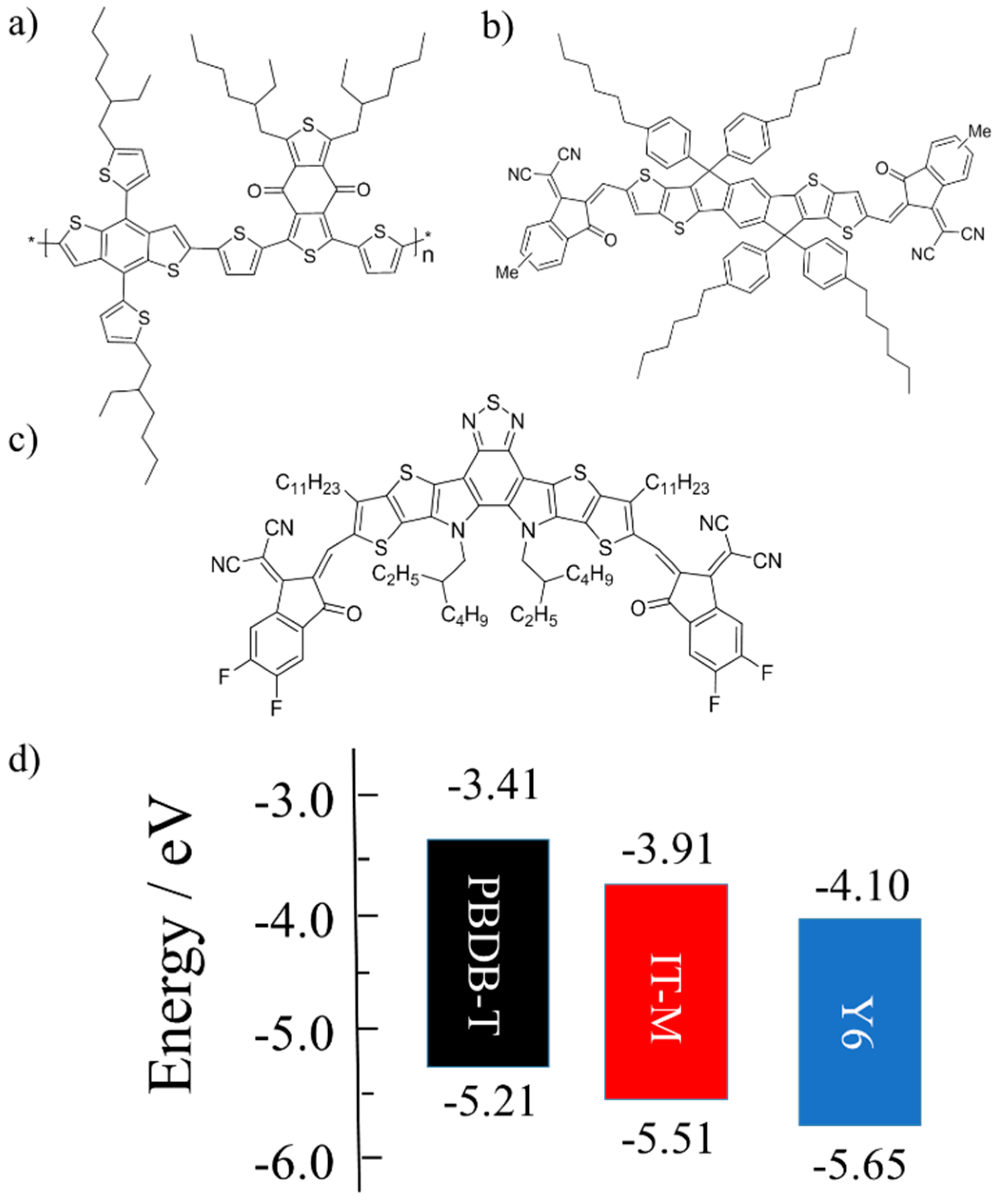
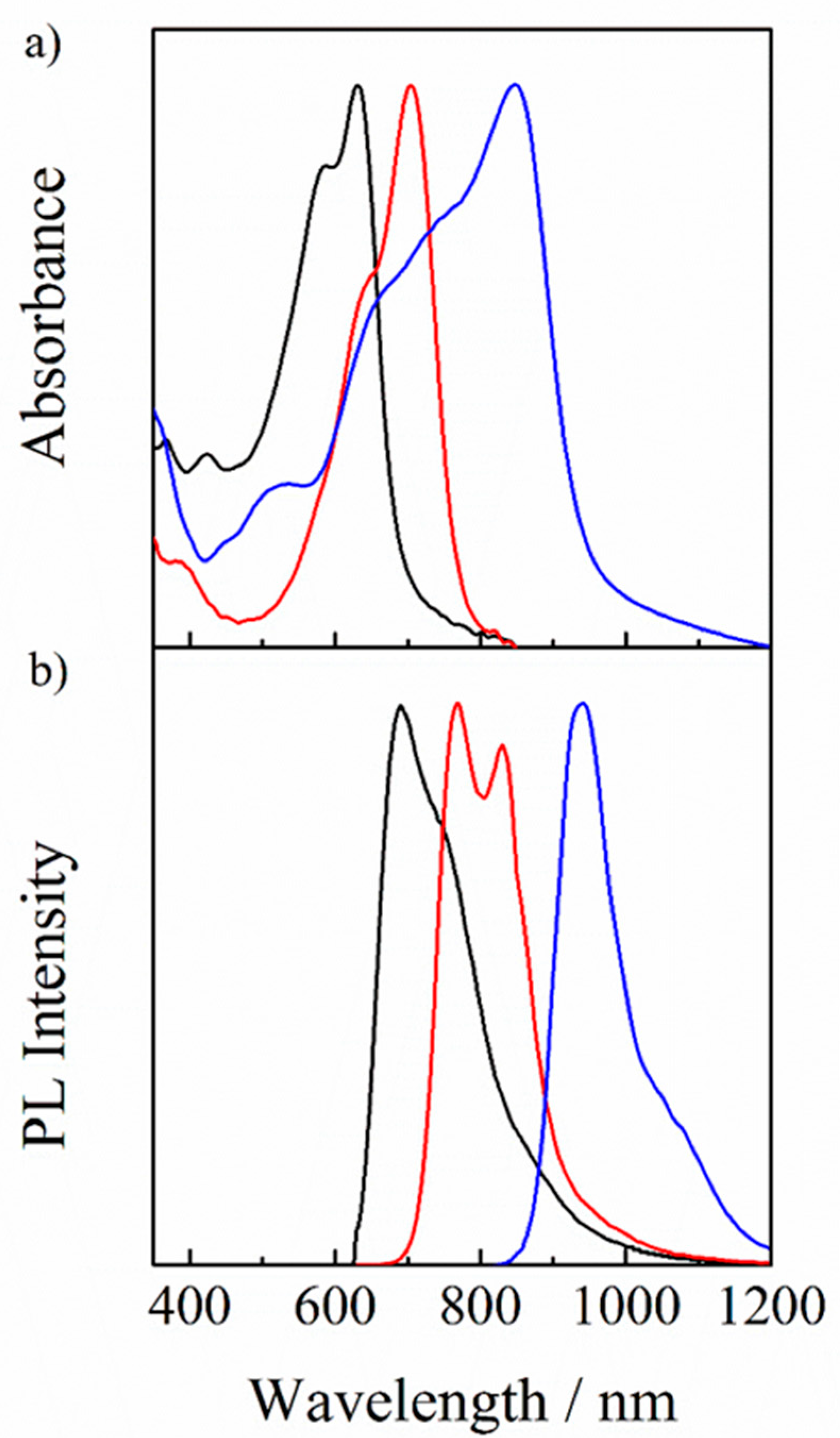

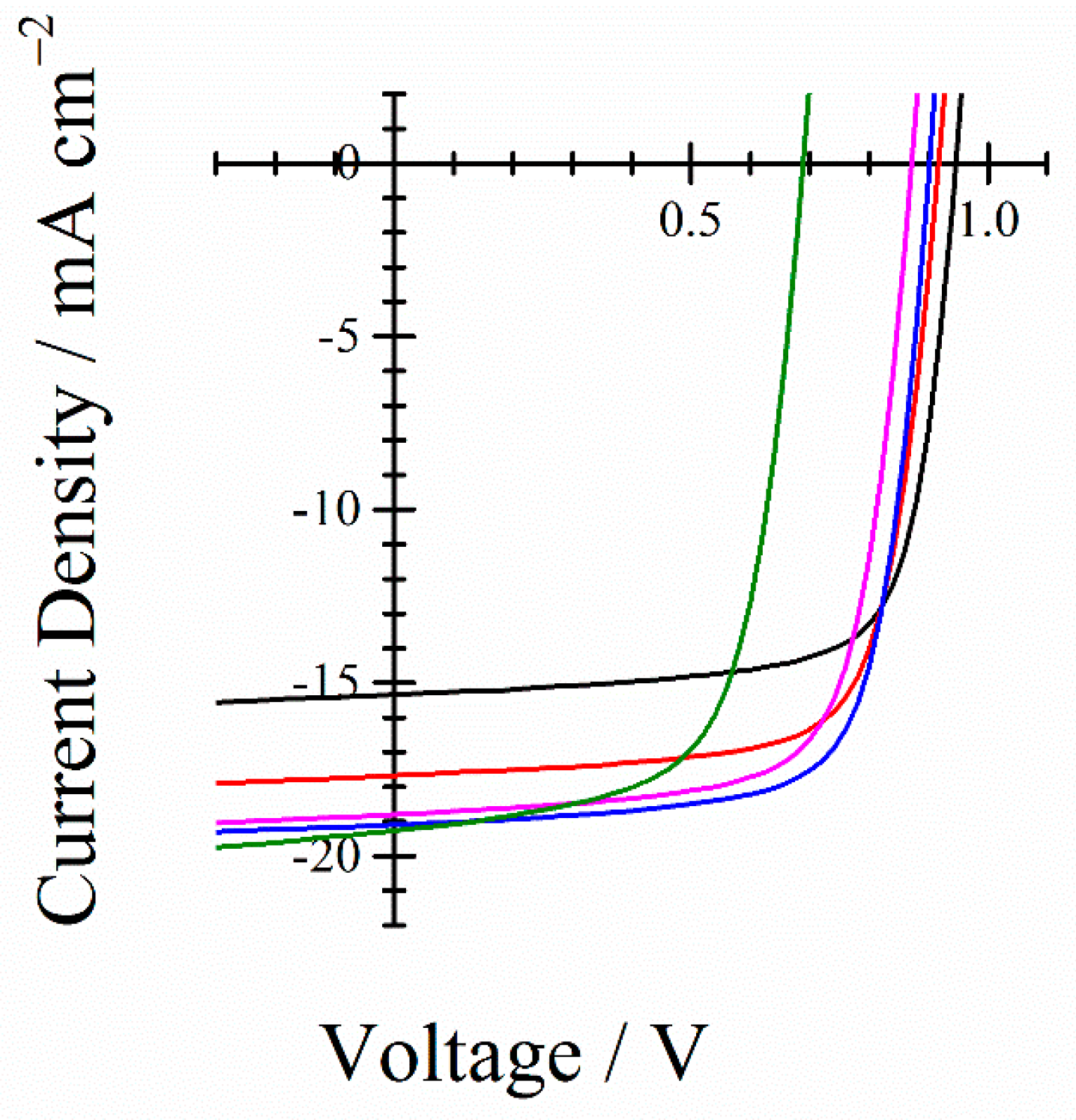
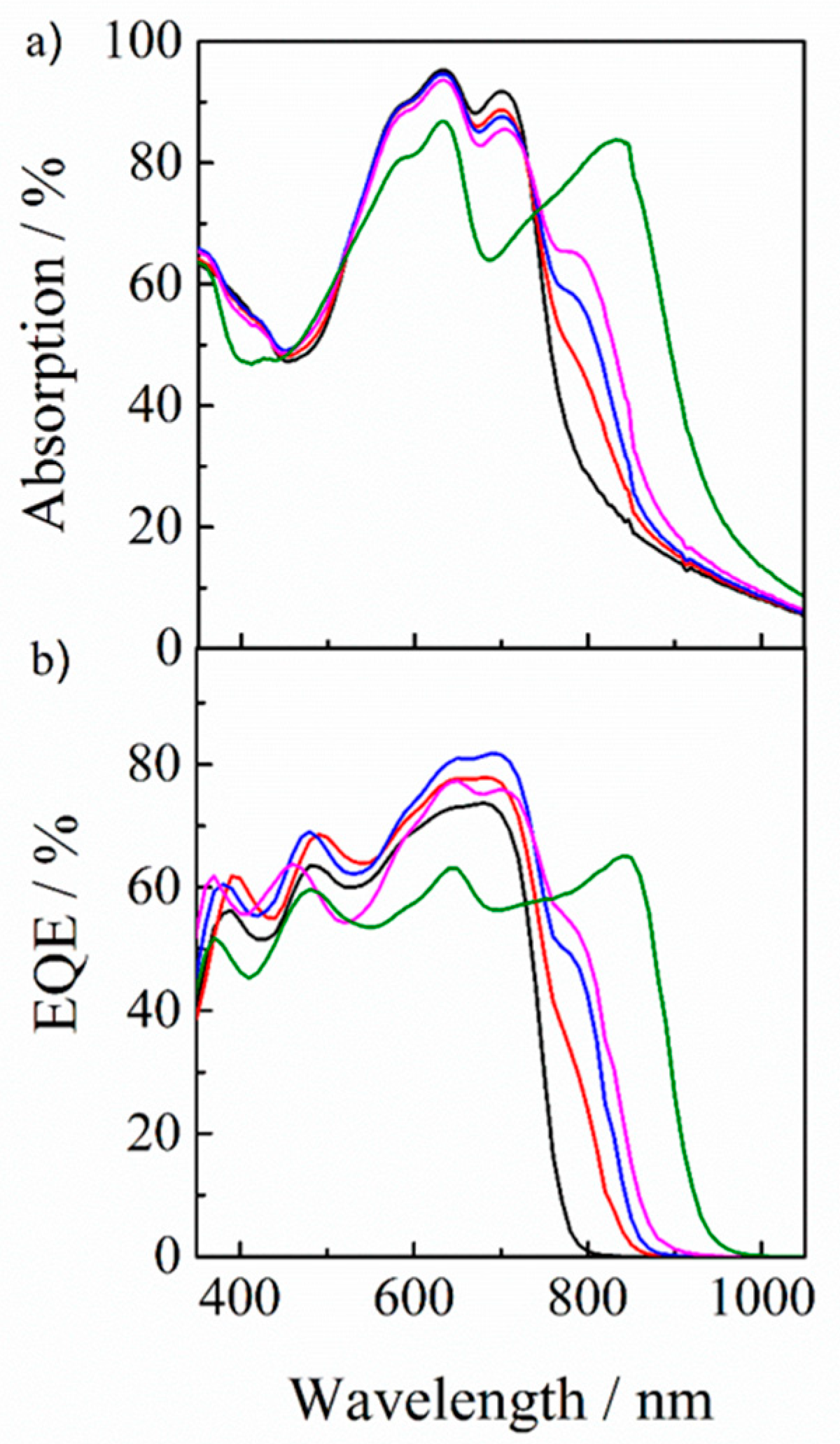
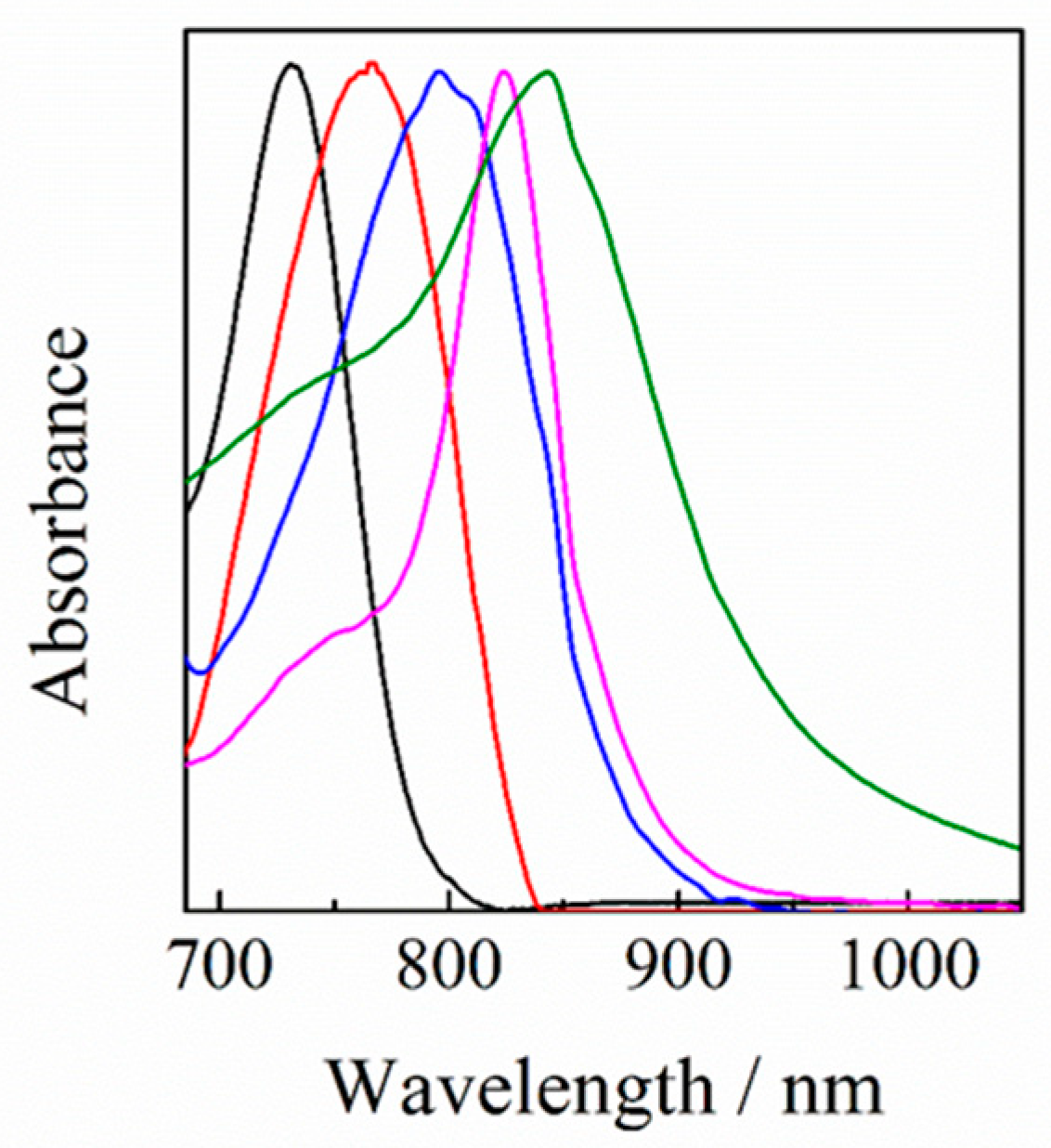
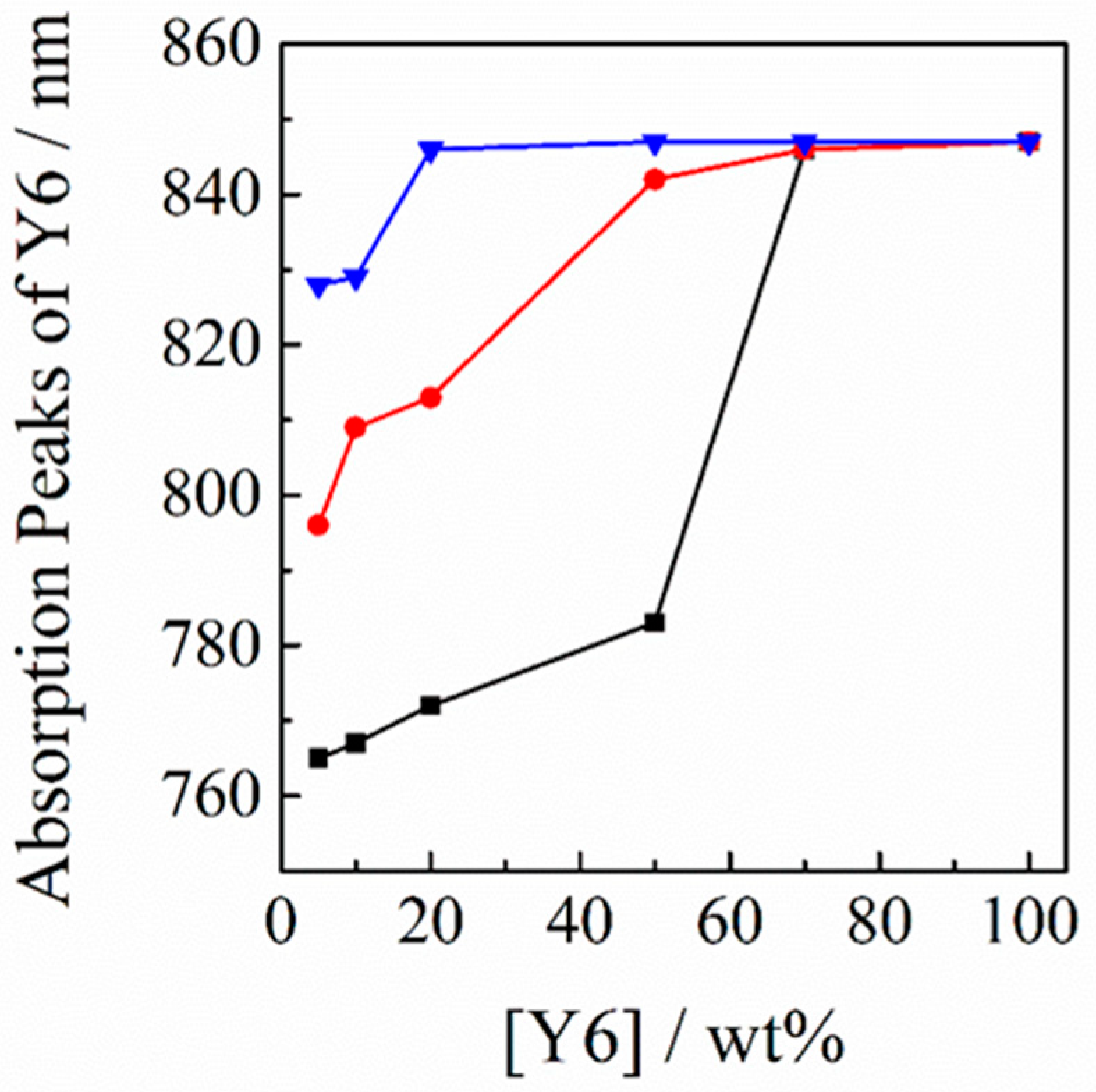
| PBDB-T/IT-M/Y6 | JSC/mA cm–2 | VOC/V | FF | PCE a/% |
|---|---|---|---|---|
| 1 : 1 : 0 | 15.34 (15.02 ± 0.32) | 0.946 (0.944 ± 0.002) | 0.734 (0.718 ± 0.016) | 10.65 (10.28 ± 0.27) |
| 1 : 0.9 : 0.1 | 17.68 (17.24 ± 0.44) | 0.917 (0.916 ± 0.001) | 0.728 (0.701 ± 0.027) | 11.72 (11.34 ± 0.38) |
| 1 : 0.8 : 0.2 | 19.09 (18.72 ± 0.37) | 0.902 (0.901 ± 0.001) | 0.726 (0.713 ± 0.023) | 12.50 (12.25 ± 0.22) |
| 1 : 0.7 : 0.3 | 18.80 (18.37 ± 0.43) | 0.872 (0.870 ± 0.001) | 0.711 (0.693 ± 0.018) | 11.65 (11.62 ± 0.33) |
| 1 : 0 : 1 | 19.27 (19.05 ± 0.22) | 0.689 (0.687 ± 0.002) | 0.647 (0.625 ± 0.022) | 8.60 (8.34 ± 0.26) |
| Materials | Y6 | RRa-P3HT | PBDB-T | PS |
|---|---|---|---|---|
| γ/mJ m–2 | 17.3 | 19.9 | 22.9 | 25.6 |
© 2020 by the authors. Licensee MDPI, Basel, Switzerland. This article is an open access article distributed under the terms and conditions of the Creative Commons Attribution (CC BY) license (http://creativecommons.org/licenses/by/4.0/).
Share and Cite
Wang, Y.; Zhuang, C.; Fang, Y.; Kim, H.D.; Yu, H.; Wang, B.; Ohkita, H. Improvement of Exciton Collection and Light-Harvesting Range in Ternary Blend Polymer Solar Cells Based on Two Non-Fullerene Acceptors. Nanomaterials 2020, 10, 241. https://doi.org/10.3390/nano10020241
Wang Y, Zhuang C, Fang Y, Kim HD, Yu H, Wang B, Ohkita H. Improvement of Exciton Collection and Light-Harvesting Range in Ternary Blend Polymer Solar Cells Based on Two Non-Fullerene Acceptors. Nanomaterials. 2020; 10(2):241. https://doi.org/10.3390/nano10020241
Chicago/Turabian StyleWang, Yanbin, Changlong Zhuang, Yawen Fang, Hyung Do Kim, Huang Yu, Biaobing Wang, and Hideo Ohkita. 2020. "Improvement of Exciton Collection and Light-Harvesting Range in Ternary Blend Polymer Solar Cells Based on Two Non-Fullerene Acceptors" Nanomaterials 10, no. 2: 241. https://doi.org/10.3390/nano10020241
APA StyleWang, Y., Zhuang, C., Fang, Y., Kim, H. D., Yu, H., Wang, B., & Ohkita, H. (2020). Improvement of Exciton Collection and Light-Harvesting Range in Ternary Blend Polymer Solar Cells Based on Two Non-Fullerene Acceptors. Nanomaterials, 10(2), 241. https://doi.org/10.3390/nano10020241





